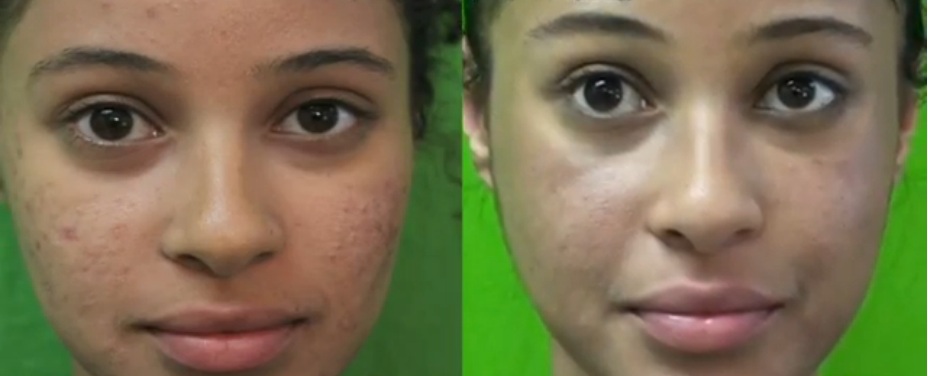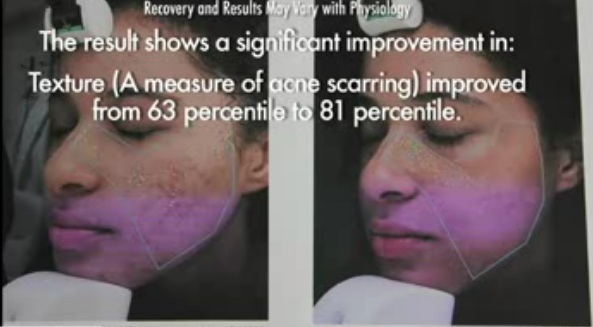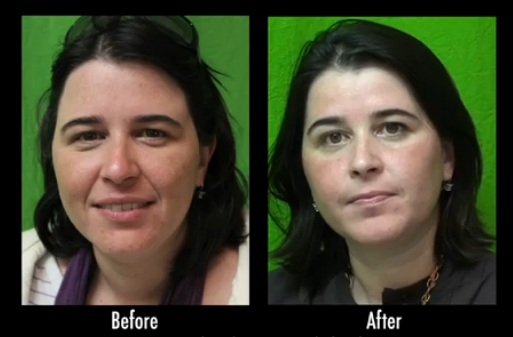Getting rid of acne scars may be challenging, but not impossible. This tissue is made of thickened collagen tissue that becomes a part of your skin’s structure. However, through modern dermatology treatments, it is possible to considerably improve the appearance of acne scars by encouraging the growth of normal collagen fibers.
How Do Acne Scars Form?
Acne scars develop from inflammation. When pores are blocked, oil from the sebaceous glands cannot flow freely onto the skin’s surface. It therefore becomes trapped. This provides an excellent environment for bacteria to reproduce and thrive. However, your immune system will react to these micro organisms and attempt to destroy them through an inflammatory reaction where white blood cells are dispatched along with chemical agents aimed to get rid of the bacteria.
Skin tissue, such as the walls of the hair follicle can suffer damage during this process. To heal this damage, the skin will produce thick bundles of collagen fibers.
According to Sherratt et al, the composition of this collagen is the same as the fibers produced throughout your skin. However they are arranged differently. This is why acne scars have a thicker texture.
In normal tissue, collagen fibers are arranged in a basket weave configuration. But scar tissue (fibrosis) consists of cross linked collagen fibers. It carries a much weaker resistance to UV rays. And unlike normal skin, it lacks the presence of hair follicles.
The dense buildup of collagen results from the proliferation of fibroblast tissue.
Types of Acne Scars
Ice pick scars
- resembles indented pits on the skin
Box car scars
- angular in shape
- resembles scars left after chicken pox
- tend to manifest on the temples and cheeks
Rolling scars
- have a wave-like appearance
- occur from bands which form in deeper skin structures
Hypertrophic scars
- similar in appearance to keloid scars
- red in coloration
- raised on the skin’s surface
Types of Treatments For Acne Scars
A general list of treatments available to patients for addressing acne scars include:
(1) punch graft surgery
(2) microdermabrasion
(3) dermabrasion
(4) chemical peels
(5) cosmetic lasers
(6) topical retinoids
(7) dermal fillers
Punch Graft Surgery
With this type of procedure, a punch tool is needed to remove individual acne scars. The resulting gap is then filled with skin grafted from a more discrete area of the body (e.g. behind the ear) to essentially replace the scar tissue that was removed.
The edges of the graft may create slight irregularities in the surface texture of the skin. Therefore, microdermabrasion or chemical peels may be used to help even this out.
Microdermabrasion
Microdermabrasion can be thought of as a light form of exfoliation which can be used to treat very minor cases of acne scarring as opposed to moderate or severe cases. This treatment is performed using magnesium salt crystals that have been finely ground.
Dermabrasion
Dermabrasion is a very invasive procedure that aggressively ablates the outer skin layer using a textured metal surface (e.g. diamond fraise) This form of treatment entails substantial bleeding. Healing often requires a three month period.
Results can be quite amazing for the right candidates. This procedure is often recommended for individuals with very fair skin where the risk of scarring is much less than in those with darker tones.
Chemical Peels
Chemical peels involve the use of chemicals to gently remove the outer layer of the skin. While this approach may offer some improvements for very minor cases, it would not remove the thickened collagen which makes up the acne scar tissue.
More aggressive forms of chemical peels are available. But it is difficult to control how deeply chemical solutions will penetrate the skin. Therefore, actual results and safety may not be very predictable or easy to anticipate.
Cosmetic Lasers
According to Dr. U, the best way to promote successful acne scar treatment results is to first control the active acne to prevent the formation of new scar tissue.
The Office of Dr. U has experienced wonderful success through the use of the Lutronic Spectra laser which is capable of targeting multiple causal factors resulting in even the most stubborn acne pimples. It’s wavelength energy is able to unblock pores, destroy bacteria and reduce the activity of oil glands by burning away the outer layer of tissue.
Once this phase is complete, the acne scar tissue can be effectively addressed. Laser systems like Fraxel Repair and Fraxel Dual can be employed to promote the formation of new collagen tissue to greatly improve the skin’s texture and render the acne scars far less visible.
Lasers offer a higher level of depth control compared to chemical peels and are thus safer for patients.
Topical Retinoids
Topical retinoids are essentially derivatives of Vitamin A. Examples include:
- Retin A
- Retinoic acid
- Retinol
These compounds help improve the rate of skin cell turnover and may be somewhat useful with very mild forms of acne scarring. Likewise, their properties can be helpful for supporting the main treatment strategy.
Dermal Fillers
Dermal fillers like Juvederm can be injected to help raise the depressed base of the acne scars, creating the appearance of more evenly textured skin. While this may be helpful as an immediate short term solution (e.g. photo shoots, events, television and video appearances), the results are only temporary since the body will eventually metabolize the filler.
Getting Rid of Acne Scars With Fraxel Lasers
Acne scars originate from deeper skin layers. Innovations in cosmetic lasers have made it possible to address this issue from beneath the surface.
Fraxel lasers work to stimulate the development of new collagen fibers. This tissue will fill in the acne scar depressions to create smoother looking skin. The Office of Dr. U offers Fraxel acne scar treatments through the following systems:
1) Fraxel Repair
- recommended for Fitzpatrick types I-III who have very light skin tones due to minimal concentrations of melanin in their skin
- ablative carbon dioxide laser system which vaporizes and heats tissue to promote the formation of normal collagen which fills in the acne scar depressions to create a softer, smoother skin texture
2) Fraxel Dual
- uses the 1550 nm wavelength mode to treat deeper areas of the skin
- also uses the 1927nm wavelength mode to treat issues closer to the skin’s surface
- safe for all skin tones
- offers a non-ablative form of treatment where unwanted cells are not removed
How much do Fraxel laser treatments cost?
The price of each session depends on how intense the procedure is. But on average, treatments cost about $1750 a session
What Patients Need to Know About Choosing An Acne Scar Treatment
Perhaps more important than having the right technology, is being able to apply the right expertise for real improvement. This includes the following types of knowledge:
1) what laser to use for a particular skin type
2) how to clear up the existing acne before treating the acne scars
3) how to set the correct laser parameters for optimal outcome
Acne Scar Treatment Photos
Here are two Fine Touch Dermatology patients who benefited from Fraxel Dual procedures for acne scars:
This patient’s results were validated through a VISIA digital imaging analysis:
Patient Videos
You may also be interested in watching the videos of these patients to learn more about their experiences and hear their feedback.
Consultations For Getting Rid of Acne Scars
Fine Touch Dermatology offers free online consultations and a complementary VISIA skin complexion analysis. We encourage patients in the greater Los Angeles area who want to get rid of their acne scars to visit the clinic and take advantage of the VISIA skin analysis. We will evaluate your case and discuss the best form of treatment for real improvements.
To get started, fill out our consultation form at the top of the page. Or you may call us at 1-800-499-DRU-CLINIC to schedule an appointment.
Related Articles
- The Burden of Acne Scars: How to Get Rid of Them
- Does Laser Work For Improving Acne Scars? – Patient Results
- Fraxel Restore Used To Treat Acne Scars on the Face
- Achieving Smooth Skin When You Have Acne Scars
- Solutions For Acne Scars in Los Angeles
- Prevention and Treatment of Acne Scars
- Acne Scars and Treatment Options
- What Works And What Doesn’t When Treating Acne Scarring
- Laser Resurfacing for Acne Scars
- Fraxel Dual Laser Corrects Acne Scars on African American Skin
- Fraxel Dual Corrects Acne Scarring- Before and After Video
- Acne Scars Are The Pits! Effective Treatment To The Rescue
- Lasers Versus Topical Interventions For Acne Scars
- Acne Scar Removal and Photodynamic Light Therapy
- Laser Skin Rejuvenation to Finally Clear Those Acne Scars



